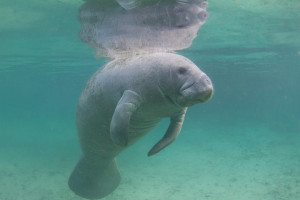 We’re in the midst of manatee season down here in South Florida. The season begins November 15 and goes until March 31. This year, the government will make a decision on whether or not the manatees will still have an endangered species status. Over the years, the manatees numbers have grown, which is why this change of status may occur. Right now, the manatees’ numbers are around 6,300 in Florida; back in 1991, this number was at 1,267. In the last 26 years, the U.S. Fish and Wildlife Service and local governments have helped create more than 50 manatee protection zones, boating rules, and restricted construction of docks in certain habitats.
We’re in the midst of manatee season down here in South Florida. The season begins November 15 and goes until March 31. This year, the government will make a decision on whether or not the manatees will still have an endangered species status. Over the years, the manatees numbers have grown, which is why this change of status may occur. Right now, the manatees’ numbers are around 6,300 in Florida; back in 1991, this number was at 1,267. In the last 26 years, the U.S. Fish and Wildlife Service and local governments have helped create more than 50 manatee protection zones, boating rules, and restricted construction of docks in certain habitats.
Around 95 manatees were killed in 2016 by boats and other watercrafts. With such a high number of manatees being killed last year and this season, the U.S. Fish and Wildlife Service urges boaters to be extra careful.
There is a proposal to change the manatees from endangered to threatened species. However, many scientists are opposed to it because it would remove federal protection from manatees in the Caribbean, whose numbers aren’t as high as the ones living in Florida. They also think loss of seagrass habitation, climate change, and increases in Florida’s human population will lower the manatees numbers again. They believe there may not be enough progress to demote them to a threatened species. The executive director of the Save the Manatee Club feels the change to threatened from endangered could lead to fewer manatee-safety zones and less caring with boaters.
As of now during the season, slower speed limits go in effect for boaters. Boaters are asked to wear polarized sunglasses to better spot manatees and abide by the speed limits put in place.
According to the Florida Fish and Wildlife Conservation Commission, manatees are a “keystone species;” their behaviors can alert researcher to environmental changes. The Everglades Park monitors the manatees by tagging them.
Glide by the Manatees
Although not guaranteed, you may get the chance to see a manatee on an airboat tour through the Everglades. If not, don’t worry there are so many other animals and marine life you can spot on a ride. Book an airboat adventure today with Captain Mitch’s Airboat Tours. Click here or call 800-368-0065 to book your trip.







